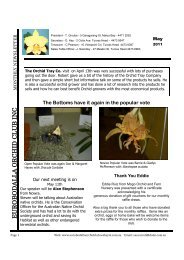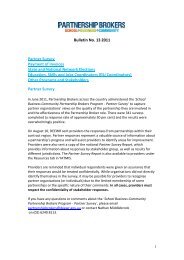Orchid Growing Substrates
Orchid Growing Substrates
Orchid Growing Substrates
Create successful ePaper yourself
Turn your PDF publications into a flip-book with our unique Google optimized e-Paper software.
- It started to be the decline of the coconut products, especially in the Netherlands, where many<br />
growers, originally enthusiastic, experienced severe problems, which killed sometimes their entire<br />
crops. It appears that coir as well as cocochips cannot be managed for a culture like orchid culture,<br />
whilst they can be managed well in a hydroponics system, strong growing plants, short cycles, and<br />
more important massive amount of water applied to the coconut or coir slabs in the hydroponics<br />
system. This alleviates any micronutrient deficiencies, even if the coconut product would catch any,<br />
as there would be always fresh fertilizer around the roots.<br />
- Coconut products have an out of range pH for many crops, in the 6.2, which is strongly buffered at<br />
that level, which brings a lot of issues with the fertilizers.<br />
- It appears today that, some growers have been too optimistic with their use of the coconut products,<br />
because they looked ‘optically’ perfect. They were not exactly the panacea, and many growers have<br />
abandoned them. It is weird to note too that most major nurseries in the Netherlands would never,<br />
ever, want to hear about coconut product forever.<br />
- Coconut products were supposed to be very stable, due to their lignin content, however it was not<br />
true, and coconut products can decompose very quickly, depending again on the source, the<br />
environment, the age, and the growing conditions.<br />
- Coconut is an exceedingly good support to grow mushrooms, as, once washed, it supports readily<br />
mycelium. It is not exactly what we would expect from a proper orchid potting mix.<br />
- There are only FOUR ways to use coconut products in horticulture as of today:<br />
o<br />
o<br />
o<br />
o<br />
Use in a hydroponic system, with heavy flushing using divalent cations ( calcium nitrate,<br />
supplying the divalent cation Ca++) during the first days or weeks of culture)<br />
Use in pots blended with calcium supplementing compounds, such as lime (but remember<br />
that coconut coir tends to be already too alkaline), or gypsum. Eventually with some other<br />
additives to lower the pH, but this could not be used for salts sensitive or fragile plants, as<br />
nevertheless, the sodium that will be purged from the coconut products will be in contact<br />
with the roots, hence taken up by the roots.<br />
A very complicated and fast process, under high pressure, with hydraulic presses and water to<br />
process and neuter the coconut product quickly.<br />
Or another process, involving soaking coconut products in water containing a high rate of<br />
calcium nitrate for some days, changing the water periodically, and analyzing the batch for its<br />
sodium and potassium extra content.<br />
- There are intermediate ways to use coconut products, as previously said, the sodium and potassium<br />
will be slowly released over some months, if no calcium and magnesium (divalent cations) are<br />
supplemented, so some growers have success using fertilizer without calcium and magnesium, and<br />
flushing, though they will have calcium and magnesium deficiencies at a point. By avoiding calcium<br />
and magnesium in the fertilizer, they avoid the basic coconut problem: sodium release. However,<br />
there are more problems, including chronic deficiencies, and this phytotoxicity, unexplained as of<br />
today, syndrome. It appears though that the heavy flushing in hydroponics drip systems gets rid of the<br />
problematic chemicals, whereas in a pot, as we do not flush several times per day, the level will build<br />
up, up to an even more toxic level.<br />
Xavier Garreau de Loubresse<br />
20
















